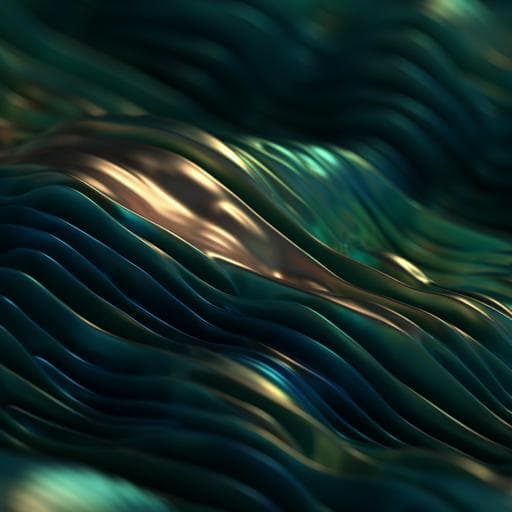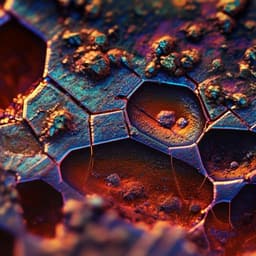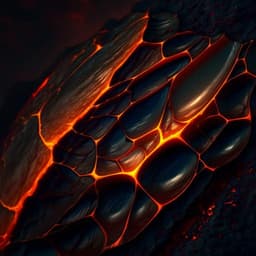
Engineering and Technology
High-precision in situ 3D ultrasonic imaging of localized corrosion-induced material morphological changes
Y. Chen, Z. Yang, et al.
Discover a groundbreaking ultrasonic technique developed by Yunda Chen and colleagues for precise 3D monitoring of corrosion in carbon steel. With ultra-high resolution and impressive accuracy, this research sheds light on the dynamics of iron dissolution and corrosion product deposition in alkaline environments.
~3 min • Beginner • English
Introduction
The study addresses the need for direct, non-intrusive, in situ 3D monitoring of localized corrosion morphologies, a critical problem given the high cost and structural risks associated with steel corrosion. Localized corrosion, driven by spatial non-uniformities, is harder to detect and predict than uniform corrosion and often causes premature failures. Existing in situ imaging techniques (STM, AFM, confocal and optical microscopy) cannot see through corrosion product layers, while XCT involves high-energy radiation and slow acquisition, limiting capture of transient phenomena. Electrochemical mapping approaches may perturb the system or confound Faradaic and non-Faradaic currents. The research question is whether an ultrasonic approach can provide high-precision, in situ, 3D, product-layer-immune monitoring of localized corrosion kinetics and morphologies, and thereby reveal mechanistic links between corrosion product formation and transient changes in corrosion rate.
Literature Review
Prior work has applied various in situ microscopies (STM, AFM, confocal laser scanning microscopy, optical microscopy) to observe corrosion morphology evolution but these cannot penetrate corrosion product layers. XCT enables subsurface observation but may alter corrosion kinetics due to high-energy radiation and has long scan times (tens of minutes), hindering observation of transients. Electrochemical approaches (wire beam electrodes, scanning reference/vibrating electrode techniques) infer morphology from local electrochemical signals but can be limited by electrode discretization artifacts, initial surface mismatches, and inability to distinguish Faradaic from non-Faradaic currents. Previous ultrasonic studies by the authors achieved high-accuracy monitoring of uniform corrosion with nanometric resolution and minimal perturbation, but lacked in-plane spatial resolution, motivating the present development for localized corrosion with 3D capability.
Methodology
A 2D multi-element piezoelectric transducer array (PZT-5H, 6×6 elements, each 4×4×0.25 mm, 1 mm gap) is epoxy-bonded to the non-working surface of a 10 mm thick NAK80 steel substrate. The array excites 2 MHz shear waves and records reflections from the working surface while a corrosion cell on the opposite side circulates electrolyte and applies DC via customized counter electrodes. A robotic arm connects an AWG/oscilloscope to each element in a round-robin manner to insonify finite micro-sections (lateral resolution customizable; here ~5 mm×5 mm, FoV ~30 mm×30 mm, determined via Huygens principle and FEM simulations). A resistance temperature detector (RTD) records temperature for velocity compensation. Thickness at each micro-section is computed as Th = V(T)·(ToA2 − ToA1)/2, where ToA1 and ToA2 are time-of-arrivals of the first two reflected shear-wave packets. ToAs are estimated by averaging 100 acquisitions, 5th-order Butterworth bandpass filtering (1.2–2.8 MHz), autocorrelation, up-sampling from 200 to 800 MHz, and gradient-based interpolation to locate the true peak positions. Temperature dependence of shear-wave velocity V(T) for each micro-section is calibrated in a 24 h non-corroding measurement using the known substrate thickness and ToA differences, then modeled by linear regression against the RTD temperature. Axial resolution is evaluated by reconstructing constant thickness over temperature transients and computing the standard deviation. Localized corrosion experiments used NAK80 steel (composition provided) with different corrosion cell geometries to impose distinct current fields (cylindrical with carbon bar, rectangular with copper plates, rectangular with copper mesh). Electrolytes included 3.5 wt.% NaCl (neutral), alkaline (3.5 wt.% NaCl + 0.1 M NaOH, pH 13), and acidic (3.5 wt.% NaCl + HCl at pH 1 or 3). Applied DC was typically 50 mA; durations ranged 3–6.5 h. Morphological evolution was reconstructed over time by interpolating micro-section thickness losses. Ex situ white light interferometry (optical profiler) measured end-state topography for neutral cases after removing corrosion products. XRD characterized corrosion products on substrates or precipitates in residual electrolyte. Numerical predictions of morphology were generated from FEM current fields and Faraday’s law assuming Fe → Fe2+ + 2e−. Additional control experiments verified ultrasound did not affect corrosion kinetics (details in Supplementary Information).
Key Findings
- Ultrasonic system performance: Temperature-compensated shear-wave velocity decreased linearly with temperature. Axial resolution (mean standard deviation of constant-thickness reconstructions) was 85 nm, demonstrating ~100 nm-level axial resolution; lateral resolution ~5 mm set by array and frequency; FoV ~30×30 mm.
- Validation against models and optics: In Experiments #1–#3 (neutral NaCl, varying current fields), ultrasonic reconstructions of morphology evolution matched FEM-predicted trends, but observed thickness losses were consistently more severe than idealized dissolution predictions. End-state morphologies measured ultrasonically agreed with optical profilometry with a mean difference of 6.77%; discrepancies occurred mainly at steep surface gradients due to wavefront/path deviations.
- Product-layer penetration: In Experiment #4 (alkaline pH 13, copper mesh, same current field as #3), a dark adherent corrosion product layer remained; XRD identified β-FeOOH, γ-FeOOH, and Fe3O4. Ultrasonic maps still captured morphology through the product layer and showed more localized attack in high-current-density regions than in neutral conditions.
- Transient corrosion-rate surges linked to product formation: Repeated neutral experiment (#3R) revealed, across micro-sections, transient surges in corrosion rate coincident with transient drops in the amplitude of the first reflected wavepacket (after temperature compensation), indicating growth of a solid corrosion product layer. XRD of residual precipitates showed γ-FeOOH and Fe3O4. The transformation of γ-FeOOH to Fe3O4 (electron-consuming) likely drove increased iron dissolution beyond that expected from the applied current field alone.
- pH-dependent validation: In strongly acidic conditions (Experiment #5, pH ~1–1.3), no transient surges or amplitude drops were observed; electrolyte remained clear, consistent with suppressed Fe(OH)2 formation and subsequent transformations. In weakly acidic initial conditions (Experiment #6, pH 3 rising to ~8.1 by end), both transient surges and amplitude drops occurred; XRD detected γ-FeOOH and Fe3O4.
- Mechanistic staging under alkaline/alkalinizing environments: A three-stage process was proposed: (1) initiation and quasi-steady dissolution governed by applied current until onset of solid product layer growth (amplitude decrease); (2) acceleration of corrosion rate concurrent with continued amplitude decrease, attributed to γ-FeOOH → Fe3O4 transformation consuming electrons and promoting dissolution; (3) return toward steady-state as product layer thickens, oxygen diffusion becomes hindered, transformations slow, and adhesion degrades leading to layer detachment.
Discussion
The ultrasonic array technique directly addresses the challenge of monitoring localized corrosion beneath or through adherent corrosion products by injecting shear waves from the non-working surface, enabling real-time 3D thickness mapping with sub-100-nm axial precision and customizable lateral resolution. Agreement with optical profilometry validates accuracy, while deviations from numerical predictions highlight complexities beyond simple Fe dissolution. Time-resolved measurements revealed transient surges in corrosion rate temporally coincident with signal amplitude drops indicating solid product deposition; XRD evidence of γ-FeOOH and Fe3O4 supports a mechanism whereby electron-consuming transformation to Fe3O4 accelerates dissolution. pH-controlled experiments corroborate the dependence on Fe(OH)2 availability: strong acidity suppresses product transformations and transient kinetics, while neutral-to-alkaline conditions favor them, leading to localization in high-current-density areas. These findings enhance understanding of how corrosion products modulate localized corrosion kinetics and demonstrate that ultrasound can simultaneously track morphology and product-layer dynamics without perturbing electrochemistry.
Conclusion
This work introduces a high-precision, non-intrusive in situ 3D ultrasonic imaging method for localized corrosion, achieving ~85–100 nm axial resolution and millimeter-scale lateral resolution, and capable of imaging through corrosion product layers. The technique reconstructs spatially resolved thickness loss in real time and correlates ultrasonic signal features with corrosion product formation. Experiments across neutral, alkaline, and acidic environments show that in alkaline or alkalinizing conditions, transient surges in corrosion rate coincide with solid product deposition and γ-FeOOH to Fe3O4 transformation, which consumes electrons and accelerates dissolution; subsequent slowing corresponds to diffusion limitation and product-layer detachment. The method’s accuracy is supported by optical benchmarking (mean difference 6.77%). Future work could extend assessments to other alloys and electrolytes, increase lateral resolution and scanning speed, integrate concurrent electrochemical measurements, and model complex surface topographies to further reduce reconstruction errors at steep gradients.
Limitations
- Spatial resolution is limited by transducer element size, frequency, and substrate thickness (millimeter-scale lateral resolution in this study), potentially under-resolving very fine pit features.
- Discrepancies with optical measurements occur at steep surface gradients due to deviations of reflected wave propagation paths and waveforms from ideal assumptions.
- Validation experiments focused on NAK80 steel and NaCl-based electrolytes under imposed DC fields; generalizability to other materials and corrosion environments requires further study.
- End-state optical validation was not possible when thick adherent corrosion products remained (e.g., Experiment #4), though ultrasonic measurements still provided morphology underneath.
- Temperature compensation assumes linear velocity–temperature relationships and uniform temperature sensing representative of insonified regions.
Related Publications
Explore these studies to deepen your understanding of the subject.







